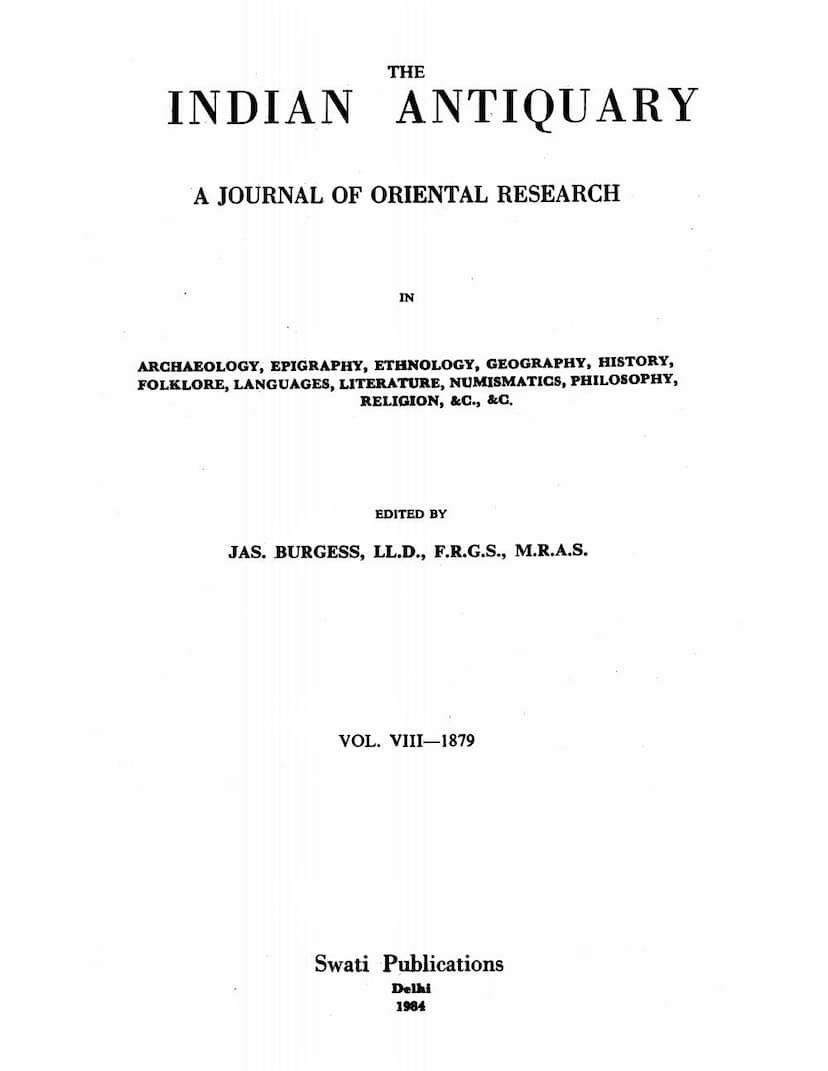Indian Antiquary Vol 08
Added to library: September 1, 2025

Summary
Here's a comprehensive summary of the provided Jain text, focusing on the content and context of the Indian Antiquary, Vol. 08, as presented in the supplied pages:
Overall Context:
The provided text is from the Indian Antiquary: A Journal of Oriental Research, Volume VIII, published in 1879 and later by Swati Publications. It is a collection of scholarly articles covering a wide range of topics in Oriental research, including archaeology, epigraphy, ethnology, geography, history, folklore, languages, literature, numismatics, philosophy, and religion. The volume features contributions from various esteemed scholars of the time, with their names and affiliations listed alphabetically in the contents.
Key Themes and Content Relevant to Jainism (as implied by the context):
While the provided pages do not contain a specific article titled "Jainism" that is directly summarized on these particular pages, the presence of Jainism as a topic in the Indian Antiquary volume indicates that the journal aimed to cover a broad spectrum of Indian religious and philosophical traditions. The mention of Jainism in the index, alongside other major Indian religions and philosophical schools, suggests that scholars contributing to this journal were interested in exploring and documenting these traditions from a historical and comparative perspective.
Specific Content Highlighted in the Provided Pages:
The bulk of the provided text focuses on historical and archaeological research, particularly concerning ancient Indian dynasties and inscriptions. Several key areas are evident:
-
Sanskrit and Old Canarese Inscriptions: A significant portion of the volume is dedicated to the transcription, translation, and analysis of Sanskrit and Old Canarese inscriptions, primarily by J. F. Fleet. These inscriptions detail the genealogies and grants of various dynasties, most notably the Western Chalukyas and the Pallavas.
- Western Chalukya Grants: Multiple grants are presented, detailing the lineage of kings like Vikramaditya VI, Pulikesi II, Kirttivarma II, and their predecessors. These inscriptions provide crucial information about the political history, administrative divisions, and dynastic relationships of this important South Indian empire. The detailed transcriptions and translations, along with discussions of paleography and epigraphy, highlight the meticulous scholarly work involved.
- Pallava Grants: The Indian Antiquary also features grants from the Pallava kings, such as Nandi Varma. The article by Lewis Rice discusses the "Chalukyas and Pallavas," noting their long-standing animosity and the potential origins of these dynasties. The detailed analysis of inscriptions related to these kingdoms provides insights into their political interactions and cultural development.
-
Early Indian Civilization: Thomas Foulkes contributes an article on "The Civilization of the Dakhan down to the Sixth Century B.C." This article draws upon various historical and mythological sources, including Ceylonese historical books, Buddhist legends, the Mahabharata, and the Ramayana, to reconstruct a picture of the material and intellectual progress in Southern India during ancient times. It discusses the existence of organized monarchical governments, cities, palaces, societal structures, arts, and religious beliefs, suggesting a sophisticated civilization predating the Christian era.
-
Folklore and Linguistic Studies:
- Indian Folklore: Monier Williams contributes "Notes on Indian Folk-lore," suggesting the need for a more systematic collection of popular traditions.
- Dravidian Languages: Rev. G. U. Pope presents "Notes on the Dravidian or South Indian Family of Languages," exploring early references and potential connections between Dravidian roots and Indo-Germanic stems.
- Santalî Vocabulary: Rev. F. T. Cole provides a vocabulary of Santalî words, indicating its connection to the Dravidian language family and exploring its relationship with Tamil and Telugu.
- The Hammira Mahakavya: Nilkantha Janardan Kirtane offers an analysis and translation of this Sanskrit poem, highlighting its historical significance and the author's poetic style, as well as its lineage of Chohan princes.
- Miscellaneous Notes: The "Miscellaneous" section includes articles on various topics, such as the "Fall of Patan Somanath" (Major J. W. Watson), "Ancient Remains in Afghanistan" (Rev. C. Swinnerton), and the "Periplús of the Erythræan Sea" (J. W. McCrindle), demonstrating the journal's commitment to diverse areas of research.
-
Other Oriental Research: The volume also includes articles on diverse subjects like the "Bhadhrachellam and Rekapalli Taluqas" (Rev. John Cain), "Customs of the Komti Caste" (Major J. S. F. Mackenzie), "A Folklore Parallel" (Prof. C. H. Tawney), and discussions on various languages and ancient texts.
Specific Jain Relevance (Inferred):
While the provided pages don't offer a deep dive into Jain doctrines, the Indian Antiquary itself, as a journal of Oriental research, would have included Jainism within its scope. The mention of Jainism in the context of early Indian religions, potentially in comparison with Buddhism (as hinted by the mention of a Congress question), suggests an academic interest in its historical roots and its relationship with other Indian traditions. The detailed analyses of inscriptions and historical periods would implicitly provide context for understanding the historical development of Jainism in relation to the broader Indian subcontinent's political and cultural landscape.
In essence, the provided pages showcase the Indian Antiquary as a vital platform for early academic study of India's rich history, culture, and religions, with Jainism being one of the many traditions it aimed to document and analyze.